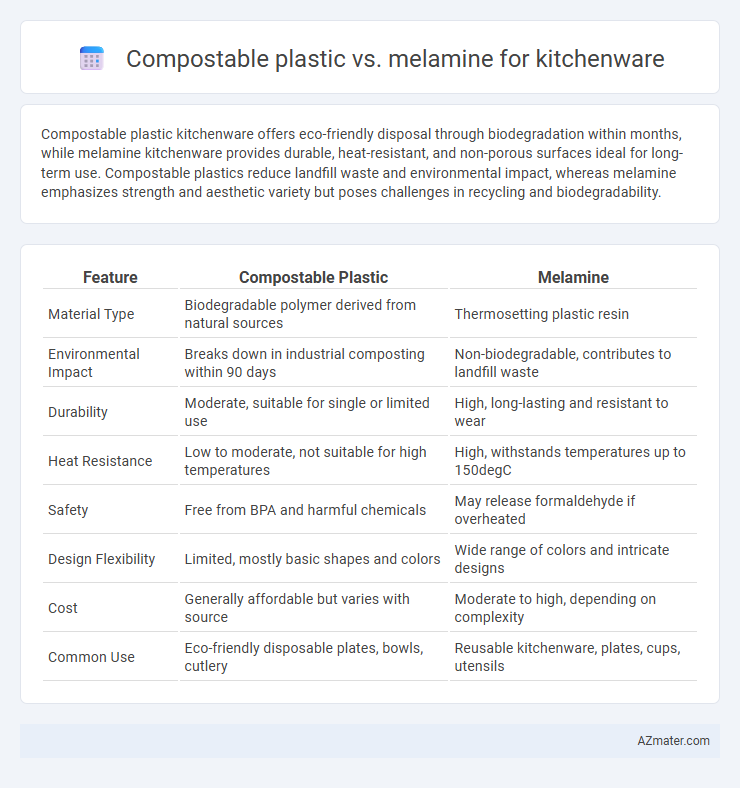Compostable plastic kitchenware offers eco-friendly disposal through biodegradation within months, while melamine kitchenware provides durable, heat-resistant, and non-porous surfaces ideal for long-term use. Compostable plastics reduce landfill waste and environmental impact, whereas melamine emphasizes strength and aesthetic variety but poses challenges in recycling and biodegradability.
Table of Comparison
| Feature | Compostable Plastic | Melamine |
|---|---|---|
| Material Type | Biodegradable polymer derived from natural sources | Thermosetting plastic resin |
| Environmental Impact | Breaks down in industrial composting within 90 days | Non-biodegradable, contributes to landfill waste |
| Durability | Moderate, suitable for single or limited use | High, long-lasting and resistant to wear |
| Heat Resistance | Low to moderate, not suitable for high temperatures | High, withstands temperatures up to 150degC |
| Safety | Free from BPA and harmful chemicals | May release formaldehyde if overheated |
| Design Flexibility | Limited, mostly basic shapes and colors | Wide range of colors and intricate designs |
| Cost | Generally affordable but varies with source | Moderate to high, depending on complexity |
| Common Use | Eco-friendly disposable plates, bowls, cutlery | Reusable kitchenware, plates, cups, utensils |
Introduction to Sustainable Kitchenware Materials
Compostable plastic and melamine represent two distinct approaches to sustainable kitchenware materials, each with unique environmental impacts and functional properties. Compostable plastics, derived from renewable plant-based sources, break down naturally under composting conditions, reducing long-term waste and carbon footprint compared to conventional plastics. Melamine, a durable resin-based material, offers longevity and resistance to heat but poses recycling challenges and environmental concerns due to its synthetic composition.
What is Compostable Plastic?
Compostable plastic is a biodegradable material designed to break down into natural elements within a compost environment, typically made from renewable plant-based sources like cornstarch or sugarcane. Unlike melamine, which is a durable, non-biodegradable resin commonly used in kitchenware, compostable plastics decompose through microbial action, reducing environmental impact and landfill waste. This sustainable option is ideal for single-use or disposable kitchen items, aligning with eco-friendly practices and waste reduction goals.
What is Melamine?
Melamine is a durable, heat-resistant plastic commonly used in kitchenware, known for its lightweight and shatterproof qualities. Unlike compostable plastics made from biodegradable materials, melamine is a hard resin derived from melamine and formaldehyde, providing long-lasting, scratch-resistant surfaces ideal for everyday dishes and utensils. Its non-porous nature makes melamine kitchenware highly stain-resistant and easy to clean but not safe for microwave use due to heat sensitivity.
Environmental Impact: Compostable Plastic vs Melamine
Compostable plastic kitchenware breaks down naturally within months under industrial composting conditions, significantly reducing landfill waste and lowering carbon emissions compared to traditional plastics. Melamine kitchenware, made from formaldehyde-based resin, is durable but non-biodegradable, contributing to long-term environmental pollution and microplastic contamination. Choosing compostable plastic supports a circular economy by minimizing plastic pollution and promoting soil health through organic decomposition.
Durability and Lifespan Comparison
Compostable plastic kitchenware offers limited durability, typically lasting a few months under regular use before degrading, whereas melamine products provide exceptional durability with a lifespan of several years due to their hard, heat-resistant resin composition. Melamine resists scratches, stains, and heat better than compostable plastics, which tend to weaken and crack over time when exposed to heat or moisture. For long-term use, melamine is the preferred choice, while compostable plastic suits short-term, eco-friendly options with quicker degradation rates.
Safety and Health Considerations
Compostable plastic kitchenware is made from plant-based materials such as cornstarch or PLA, which break down naturally without releasing harmful chemicals, making it a safer choice for health-conscious users and environmentally sensitive households. Melamine kitchenware, while durable and heat-resistant, can release toxic formaldehyde and melamine compounds if overheated or used with acidic foods, raising concerns about potential long-term health effects such as kidney issues. Therefore, compostable plastics offer a safer, non-toxic alternative for everyday use, especially when prioritizing food safety and reducing exposure to hazardous substances.
Cost Analysis and Affordability
Compostable plastic kitchenware typically costs more upfront than melamine due to the use of biodegradable materials and eco-friendly manufacturing processes, but it offers potential long-term savings by reducing environmental waste disposal costs. Melamine kitchenware is generally more affordable and durable, appealing to budget-conscious consumers seeking cost-effective options for everyday use. Evaluating affordability involves weighing the initial investment in compostable plastics against the sustained durability and lower replacement frequency of melamine products.
Design and Aesthetic Differences
Compostable plastics in kitchenware offer a natural, matte finish with earthy tones that emphasize eco-friendliness and simplicity, blending seamlessly into rustic or minimalist kitchen designs. Melamine kitchenware features high-gloss surfaces and vibrant, intricate patterns, providing a sleek, modern aesthetic ideal for contemporary or eclectic interiors. While compostable plastics prioritize organic and sustainable visual appeal, melamine excels in durability and customizable design options.
Everyday Use: Performance & Maintenance
Compostable plastic kitchenware offers lightweight durability and is eco-friendly but may degrade faster and require gentle washing to maintain integrity. Melamine kitchenware provides excellent heat resistance, scratch durability, and long-lasting performance ideal for everyday use but is not microwave-safe and must be hand-washed to prevent surface damage. Both materials require careful maintenance tailored to their physical properties to ensure longevity in busy kitchen environments.
Which Kitchenware Material is Best for You?
Compostable plastic kitchenware offers eco-friendly benefits with biodegradability and reduced environmental impact, but it may lack the durability and heat resistance found in melamine products. Melamine kitchenware provides long-lasting strength, vibrant designs, and resistance to scratches and stains, making it ideal for everyday use and dishwasher cleaning. Choosing the best material depends on whether you prioritize sustainability or durability and ease of maintenance for your kitchen needs.

Infographic: Compostable plastic vs Melamine for Kitchenware
 azmater.com
azmater.com